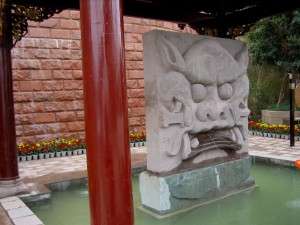 Just outside of Chengdu, the capital of Sichuan, lies the ancient Hakka town of Luodai. More than 90% of the 23,000 residents are Hakka. Sichuan, a province in southwest China, is home to more than 3 million Hakkas.
Just outside of Chengdu, the capital of Sichuan, lies the ancient Hakka town of Luodai. More than 90% of the 23,000 residents are Hakka. Sichuan, a province in southwest China, is home to more than 3 million Hakkas.
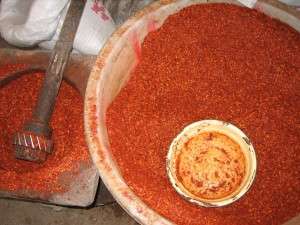 Although, the government remodeled the town with picturesque Qing-style features to attract tourists, you can find the old village hidden in the back streets. Basins of crushed dried red chiles, mountain mushrooms, and vegetables fill the marketplace. Along the dirt pathways and lanes, small shops carry out their business. A woman delivers disks of coal for cooking.
Although, the government remodeled the town with picturesque Qing-style features to attract tourists, you can find the old village hidden in the back streets. Basins of crushed dried red chiles, mountain mushrooms, and vegetables fill the marketplace. Along the dirt pathways and lanes, small shops carry out their business. A woman delivers disks of coal for cooking.
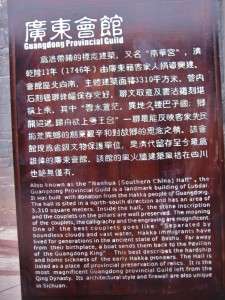 Throughout the newer renovated section, tea houses, gardens, and small shops line stone-paved streets. Several large guild complexes built by Hakkas from different provinces serve as social halls. In my research tour in 2005, we ate at two of these Hakka guilds, the Jiangxi and Guangdong.
Throughout the newer renovated section, tea houses, gardens, and small shops line stone-paved streets. Several large guild complexes built by Hakkas from different provinces serve as social halls. In my research tour in 2005, we ate at two of these Hakka guilds, the Jiangxi and Guangdong.
The Guangdong Guild was built in 1747 by the Hakkas. The host’s ancestors are from Meizhou, the same area as my own family.
Although the Hakka maintained much of their traditional cuisine, in migration they often adapted to their new homes, adding different ingredients, adjusting to local tastes, and creating new dishes. In this province, known for it spicy chile-fired cuisine, the Sichuan influences assert themselves immediately in our meals.
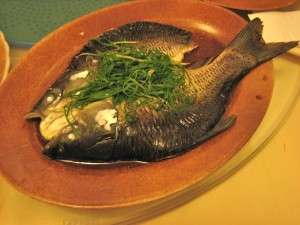 Compare steamed fish served in two different provinces. In Meizhou, in the center of the Hakka heartland in Guangdong province, the fish is steamed with just a bit of soy sauce and green onions (recipe on page 39 in The Hakka Cookbook). The natural flavor of the fish predominates.
Compare steamed fish served in two different provinces. In Meizhou, in the center of the Hakka heartland in Guangdong province, the fish is steamed with just a bit of soy sauce and green onions (recipe on page 39 in The Hakka Cookbook). The natural flavor of the fish predominates.
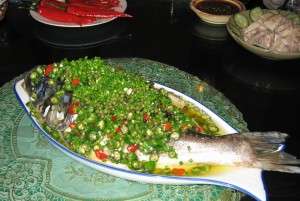 In Luodai in Sichuan province, the fish is steamed under a avalanche of fresh green peppercorns and sliced green chiles. The taste is definitely hot and spicy as many dishes are in Sichuan.
In Luodai in Sichuan province, the fish is steamed under a avalanche of fresh green peppercorns and sliced green chiles. The taste is definitely hot and spicy as many dishes are in Sichuan.
Our Hakka host explains that although the traditional Hakka flavor profile is not spicy, they added the chile pepper to their cooking to match the climate. Not all the dishes on our table were fiery hot; some emphasized natural flavors and balanced the chile-laden dishes. However, the meals in Sichuan were far more spicy than those we ate in Guangdong.
Even in China, we see the effects of migration in a simple steamed fish. As I travel more, I see the effect of migration and environment on the food we eat.
